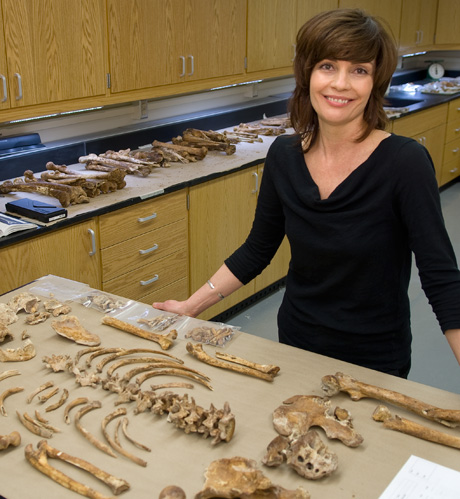Mysteries of the Deep
August 21, 2012
From Maxwell Perspective...
Mysteries of the Deep
Shannon Novak has made an accomplished career of reconstructing long-ago lives from scant (yet rich) remains.

Shannon Novak with remains from the Spring Street Presbyterian Church site
Shannon Novak first sensed the direction of her research as a bioarchaeologist back in the '90s, when training in archaeology at the University of Utah and working on prehistoric sites. "We'd do excavations and everyone would get excited about pots and arrowheads," Novak recalls. "And then we'd find a body and the archaeologists would grumble and complain." Intrigued by what the others overlooked, she took a course on human osteology, studying the skeletal system, and loved it. "The body is an extension of these other objects. It's that person who constructed the arrowhead," she says.
While completing her graduate studies, Novak landed an internship with the Smithsonian's Doug Owsley, a forensic specialist. They worked on archaeological finds at a time when the Native American Graves Protection and Repatriation Act greatly increased the demand for trained osteologists.
For Novak, a key component of bioarchaeology - studying the historical and cultural context of human remains - came into focus with her research on Utah's Mountain Meadows massacre of 1857, in which a local militia killed some 120 men, women, and children migrating west. Novak blended archival and oral history with an analysis of the skeletal remains to create what she calls a biocultural history of the massacre. The resulting book, House of Mourning (University of Utah), was published in 2008. She has since conducted a long-term ethnographic study of the victims' descendants in the Ozarks.
Novak explored another grim chapter in the history of the American West-the Donner Party - for a new book she co-edited, An Archaeology of Desperation: Exploring the Donner Party's Alder Creek Camp (University of Oklahoma). She worked on the smaller, lesser known cannibalism site, Alder Creek, where the Donner family was trapped, examining a hearth that was filled with pieces of chopped-up bone. The fragments were too small to determine species visually and DNA analysis was impossible. But through histology (the study of cell shape) the butchered species were found to include deer, oxen, and dog.
"We know from the accounts that they were eating pine needles and shoe leather and book covers - everything they could - until they sacrificed the dog and then began consuming human tissue," says Novak. "The family pet seems to have been a transition food to human corpses." As in all her work, what drives Novak's research is not just the facts gleaned from physical evidence but the human experiences behind them-in the Donner case, the unimaginable decisions people had to make to keep their families alive.
— Jeffrey Pepper Rodgers